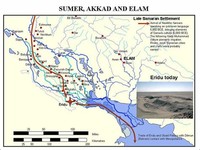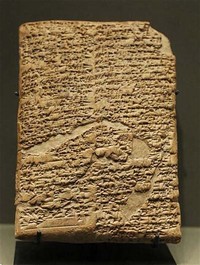Facts about Sumer

After a time the Sumerians began to place the temples on top of multi-layered square constructions built as a series of rising terraces: the ziggurats.

The Uruk period civilization, exported by Sumerian traders and colonists (like that found at Tell Brak), had an effect on all surrounding peoples, who gradually evolved their own comparable, competing economies and cultures.

Treaties from Sumeria indicate a preference for trade and commerce.
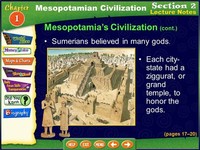
Sumerians believed that the universe consisted of a flat disk enclosed by a tin dome.
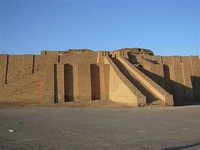
Sumerian temples and palaces made use of more advanced materials and techniques, such as buttresses, recesses, half columns, and clay nails.

The Sumerians worshipped Anu as the primary god, equivalent to "heaven"—indeed, the word "an" in Sumerian means "sky," and his consort Ki, meaning "earth."

The Sumerians used slaves, although they were not a major part of the economy.

Eridu and Nippur may be regarded as contrasting poles of Sumerian religion.

An extremely large body of hundreds of thousands of texts in the Sumerian language has survived, the great majority of these on clay tablets.

The Sumerian language is generally regarded as a language isolate in linguistics because it belongs to no known language family; Akkadian belongs to the Afro-Asiatic languages.
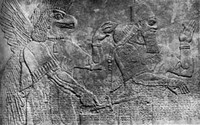
The Sumerian afterlife involved a descent into a gloomy netherworld to spend eternity in a wretched existence as a Gidim (ghost).

The cities of Sumer could not maintain remote, long-distance colonies by military force.

The Sumerian people who settled here farmed the lands in this region that were made fertile by silt deposited by the Tigris and the Euphrates rivers.

Known Sumerian texts include personal and business letters and transactions, receipts, lexical lists, laws, hymns and prayers, magical incantations, and scientific texts including mathematics, astronomy, and medicine.

The independent Amorite states of the twentieth to eighteenth centuries are summarized as the "Dynasty of Isin" in the Sumerian king list, ending with the rise of Babylonia under Hammurabi in ca.

City-States for centuries used variations of Sumerian Law, which established set penalties for particular offenses.

Sumerian culture may be traced to two main centers, Eridu in the south and Nippur in the north.
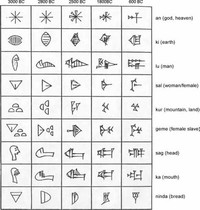
The Sumerian language has many terms for canals, dikes, and reservoirs.

Ecologically, the agricultural productivity of the Sumerian lands was being compromised as a result of rising salinity.
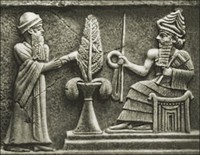
Following the Gutian period, there is a brief "Sumerian renaissance" in the 22nd century, cut short in ca.

Sumerians harvested during the dry fall season in three-person teams consisting of a reaper, a binder, and a sheaf arranger.

Sumerian speakers were farmers who moved down from the north after perfecting irrigation agriculture there.

The history of Sumeria dates back to the beginning of writing and also of law, which the Sumerian are credited with inventing.
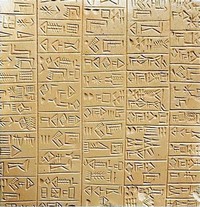
The Sumerians' cuneiform writing system is the oldest there is evidence of (with the possible exception of the highly controversial Old European Script), pre-dating Egyptian hieroglyphics by at least 75 years.

Sumerian cylinder seals also depict houses built from reeds not unlike those built by the seminomadic Marsh Arabs (Ma'dan) of Southern Iraq until as recently as C.E.
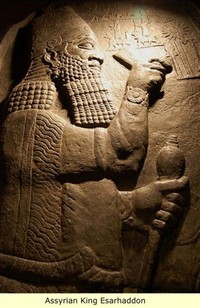
There have been many failed attempts to connect Sumerian to other language groups.

The gods often expressed their anger and frustration through earthquakes and storms: the gist of Sumerian religion was that humanity was at the mercy of the gods.

Sumerian temples consisted of a forecourt, with a central pond for purification (the Abzu).

Henceforth Sumerian would remain only a literate, sacerdotal or sacred language, similar to the position occupied by Latin in Middle Ages Europe.

The most important archaeological discoveries in Sumer are a large number of tablets written in Sumerian.

The Sumerians called themselves "the black-headed people" (sag-gi-ga) and their land "land of the civilized lords" (ki-en-gir).

Lyric poetry is a genre that, unlike epic poetry and dramatic poetry, does not attempt to tell a story but instead is of a more personal nature.

Sumerian continued to be the language of religion and law in Mesopotamia long after Semitic speakers had become the ruling race.

Speakers of Akkadian and Sumerian coexisted for about one thousand years, from 2800 to 1800, at the end of which Sumerian ceased to be spoken.

Sumerian, however, remained a sacerdotal language taught in schools, in the same way that Latin was used in the Medieval period, for as long as cuneiform was utilized.

The first true city states arose in Sumer, roughly contemporaneously with similar entities in what is now Syria and Israel.
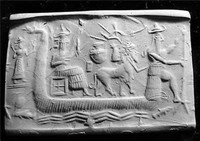
The ancient Sumerian flood myth, similar to the Epic of Gilgamesh suggests that the development of City-States was thought to be a way to ensure that peace would prevail.

More and more people became aware of belonging to the same world as a result of Sumeria's contribution to the human story.

Treaties from ancient Sumeria indicate a preference for solving disputes through negotiation.

Sumerian pre-cuneiform script has been discovered on tablets dating to around 3500 B.C.E.

The most impressive and famous of Sumerian buildings are the ziggurats, large layered platforms which supported temples.

Sumerians invented picture-hieroglyphs that developed into later cuneiform, and their language vies with Ancient Egyptian for credit as the oldest known written human language.

The Sumerians tried switching to barley, a more salt-tolerant crop.

Most authorities credit the Sumerians with the invention of the wheel, initially in the form of the potter's wheel.

The Sumerian chariot comprised a four or two-wheeled device manned by a crew of two and harnessed to four onagers.

The Sumerians were a non-Semitic people and were at one time believed to have been invaders, as a number of linguists believed they could detect a substrate language beneath Sumerian.

The almost constant wars among the Sumerian city-states for 2000 years helped to develop the military technology and techniques of Sumer to a high level.

The Sumerians engaged in siege warfare between their cities, but the mudbrick walls failed to deter some foes.
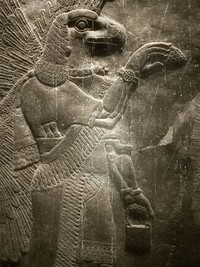
Sumer together with Ancient Egypt and the Indus Valley Civilization is considered the first settled society in the world to have manifested all the features needed to qualify fully as a "civilization."

Like other cities of Asia Minor and the Mediterranean, Sumer was a polytheistic, or henotheistic, society.

Sumerian structures were made of plano-convex mudbrick, not fixed with mortar or cement.

The Sumerians were among the first formal astronomers, correctly formulating a heliocentric view of the solar system, to which they assigned five planets (all that can be seen with the naked eye).

By the late fourth millennium B.C.E., Sumer was divided into about a dozen independent city-states, whose limits were defined by canals and boundary stones.

The Sumerians adopted the agricultural mode of life which had been introduced into Lower Mesopotamia and practiced the same irrigation techniques as those used in Egypt.

The Sumerian gods (Sumerian dingir, plural dingir-dingir or dingir-a-ne-ne) thus had associations with different cities, and their religious importance often waxed and waned with the political power of the associated cities.

Finally, the Sumerians ushered in the age of intensive agriculture and irrigation.

The Sumerian city states rise to power during the prehistorical Ubaid and Uruk periods.
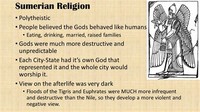
Sumerian beliefs were also the inspiration for much of later Mesopotamian mythology, religion, and astrology.

Sumerian masons and jewelers knew and made use of alabaster (calcite), ivory, gold, silver, carnelian and lapis lazuli.
